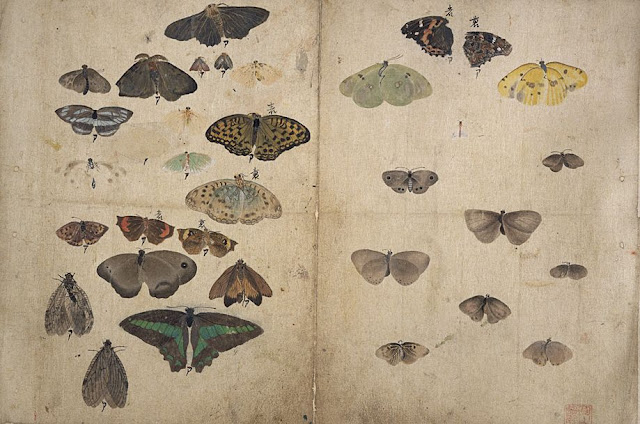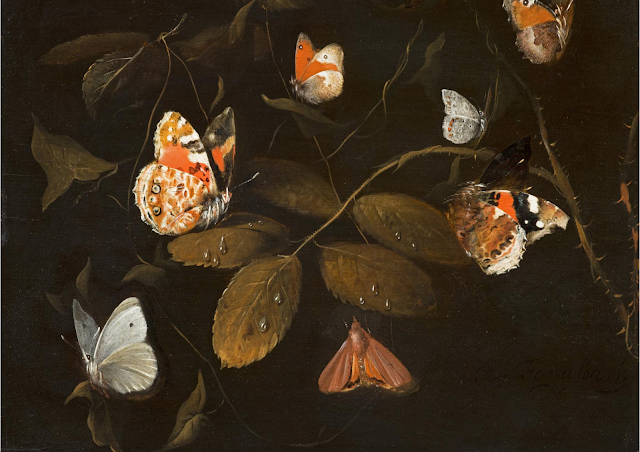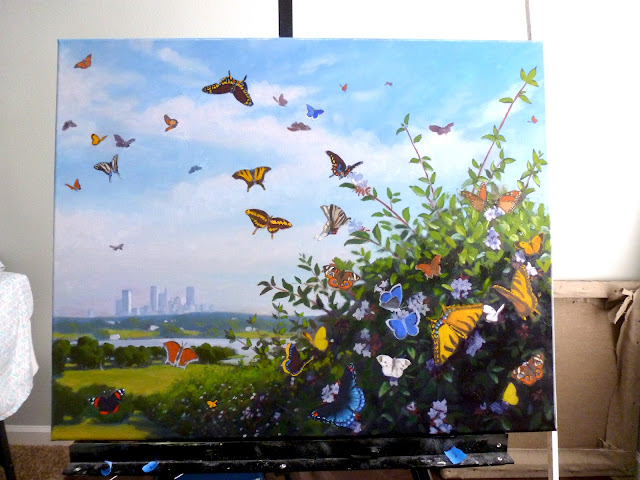Vladimir Nabokov obsessed over butterflies since he was a boy. The author of Lolita, Pale Fire, and Ada loved and admired butterflies to the point of becoming a serious lepidopterist donating collections to the American Museum of Natural History in New York and publishing in reputable scientific journals. He even discovered a few new species.
Below are some of his drawings and notes from field expeditions (among his favorite places to go collecting was the Dallas-Ft. Worth area in Texas, where I'm originally from).
In ancient Mesoamerica and the Andes, butterflies were associated with war and royalty. Butterflies were the souls of warriors killed in battle, of women who died in childbirth, and of those sacrificed to the gods. Their patterned wings were the splendid raiment of heroes who died in battle, of the self-sacrifice of martyrs, and the glory of rulers and the gods themselves.
Below are a series of elaborate incense braziers from ancient Teotihuacan showing gods and warriors wearing all kinds of animal motifs including butterflies.
A very elaborate incense burner from Teotihuacan filled with butterfly motifs starting with the nose ornament worn by a god in the very center.
Another incense burner with a god wearing a butterfly nose ornament, but other raiments recalling butterfly wings.
A magnificent head of an elderly god is all that survives of one incense burner. Projecting from his crown is a motif based on the curled proboscis mouth of a butterfly.
Another incense burner full of stylized butterflies.
A Moche gold nose ornament from Bolivia in the form of a butterfly, something worn only by a local ruler.
Below is a painting of butterflies with details by a Korean painter Moran Hojeopdo from the 15th century.
More emblems of decay at the bottom of the painting, a spider, a lizard, and a snail with decaying vegetation.
My Butterfly Paintings
In Moran Hojeopdo's painting and in a lot of other Far Eastern painting, there is a very sensitive observation of butterflies and other creatures being themselves, doing what they do in the state of nature.
Another artist who made a career of painting butterflies based on close observation of both their speciation and their habits was the 18th century Japanese painter Maruyama Okyo.
A painting by Maruyama Okyo of a hundred butterflies from the 18th century in the style and materials of Chinese traditional painting (ink and colors on raw silk) that incorporates a reliance on observation that may be partly a Western import and partly Maruyama Okyo's own inclinations.
A detail from the Hundred Butterflies painting.
Below are pages from Maruyama Okyo's sketchbooks apparently made from living and dead butterflies
This kind of close attention to species and structure was very original in Japan. While popular with the public, traditionalist critics scorned his work for relying more on direct observation and less on guidance from esteemed past masters.
The West mostly saw butterflies as flying flowers and included them in the delightful marginalia of book ornamentation from the late Middle Ages to well into the 16th century.
The splendid red admiral butterfly in Pisanello's portrait of a young princess may be a personal emblem and/or it may be an emblem of the soul. There are a lot of cultures and religious traditions that associate butterflies with death and resurrection.
This painting from the early 16th century by Benedetto Coda shows the infant John the Baptist guiding a butterfly to the Madonna and Child above, a religious symbol for the soul.
In the Low Countries of the Reformation for both Protestants and Catholics, butterflies became associated with decay and the vain things of the world of the flesh as in the anonymous memento more painting above.
Dutch flower paintings are almost always thinly veiled memento mori paintings since in the 17th century, nothing could be enjoyed without a moral lesson.
Among the best of them all, and filled with butterflies, is this painting by Jan Davidz de Heem, a Dutch artist who converted to Catholicism.
Here is his painting in the National Gallery of Art in Washington DC with selected details.
Symbols of vanity and decay or not, these are beautifully painted butterflies probably accurate enough to satisfy the most demanding lepidopterist.
Despite the vanitas moralizing still lives, the Dutch began to look at -- and collect -- the manifold small wonders of nature for their own sakes, especially butterflies. Some artists such as Jan van Kessel specialized in a kind of collectibles picture that showed butterflies, insects, and plants together not in a floral still life, but as they might appear in a collector's display cabinet/
An artist who took the bug collection back to the garden and turned it loose was the eccentric Dutch artist Otto Marseus van Schrieck. Marseus van Schrieck brought these collectibles to life in his paintings, trying to recreate something of their natural habitat. Sometimes he set them in scenes of struggle that anticipate 19th century artists from Antoine-Louis Barye to John James Audubon.
William Blake restored to butterflies something of their symbolic meaning just when scientists started describing them as living animals. Not only did butterflies symbolize the soul for Blake, but also spiritual transformation.
Probably no one integrated the unique metamorphosis of the life cycle of butterflies with the idea of spiritual metamorphosis more magnificently that Blake did in his title page for his long poem Jerusalem.
For me, butterflies are like all other beautiful things in nature, they are part of the pleasure of being alive. They are good and lovely living things in themselves before they are anything else.
Lately however, butterflies for me take on associations of loss and dread. Butterflies are scarce now in New York City. Solitary monarch butterflies flitting down streets or even avenues full of traffic on their way to Mexico were part of New York in the fall. I saw one for the first time in years on my way to work in the Bronx. City parks were once great places to spot butterflies, but now they are very rare, even in parks planted with butterfly-friendly gardens.
I've started a third butterfly painting about a vivid experience I had as a small child of a Spring afternoon in Dallas in about 1962 or 1963 with a swarm of butterflies of all different kinds in our backyard. I remember looking at them with my mother who carried a small Golden guidebook trying to identify them all. I remember some of the species there, but not all of them.
And now, the butterflies are gone, the house and its yard are gone, my mother is gone, and the whole neighborhood where this took place is gone, leveled to make way for an immense new business school with a new parking lot for Southern Methodist University which always owned most of the land under that neighborhood.
I sometimes fear that butterflies may disappear forever, part of the irrational dread I carry around that somehow I'm watching the whole world die in front of me. That may be a legacy of the pandemic.
I began the first butterfly painting in Bluffton, South Carolina soon after the deaths of two old and close friends who died just eight days apart. I made a second one in New York during the pandemic shutdown shortly before my mother died. And now I'm making a third painting after the pandemic has receded if not quite ended, and a year after my mother's death.
The first butterfly painting.
It now sits in a mini-warehouse somewhere in the Miami area and may never see the light of day again.
The first one that I made while living briefly in Bluffton, South Carolina in 2018.
This is not quite a butterfly painting. It has a few flitting around the background, but its star is an Io moth in the foreground. A friend bought this and it now hangs in her bedroom in San Francisco.
Maybe not exactly a butterfly painting, but close enough. This one is from 2019 and now belongs to my friend Tina in San Francisco.
This is the second butterfly painting that I made during the lockdown on 3 canvas panels.
This painting was the first to feature something like the old neighborhood on Fondren that would be completely destroyed in 2022.
This is the third butterfly painting that I am currently working on. It is not finished. This is how it looked on December 3, 2022.





















.jpeg)
















No comments:
Post a Comment
No anonymous comments will be accepted.
If you wish to say something dissenting or unpleasant, then do so. But, you must identify yourself either with your own name or a fake name. "Anonymous" comments will be deleted without exception.
I stand by my comments. I expect you to do likewise.